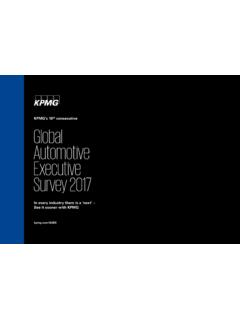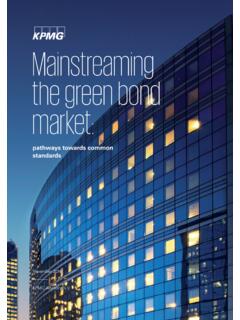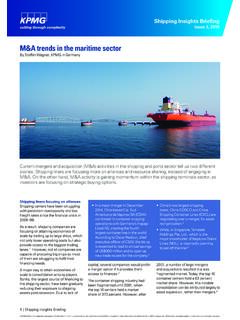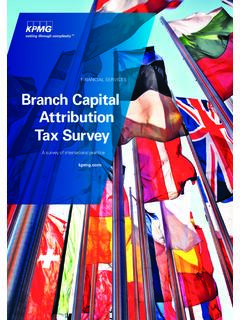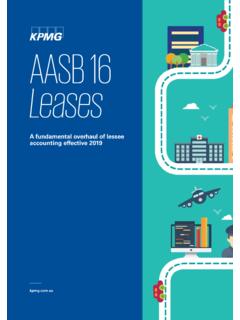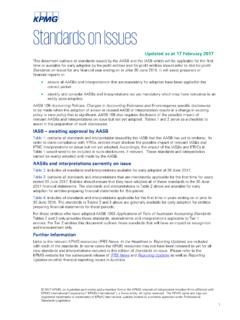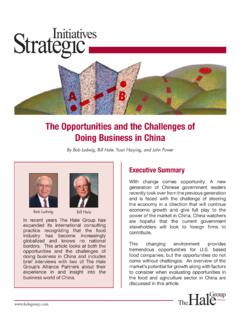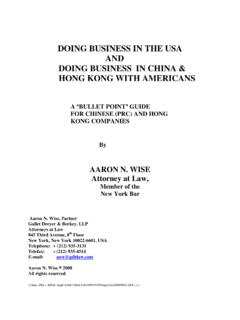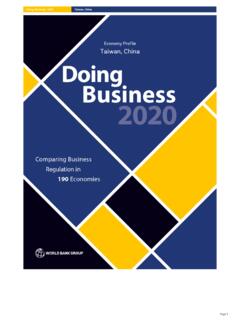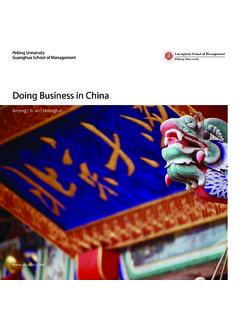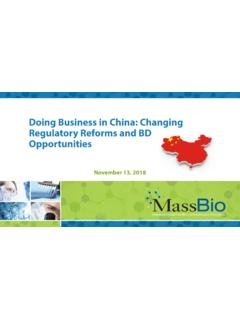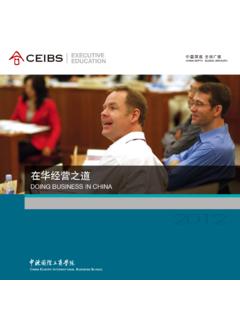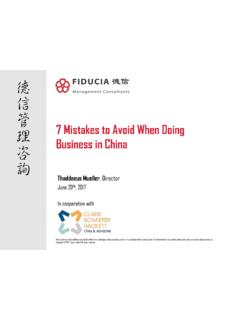Transcription of Doing Business in China - assets.kpmg.com
1 Doing Business in China Experiences and opinions of Australian companies operating in ChinaMarch 2018 At what is an important juncture in the Australia- China relationship, AustCham is proud to present the inaugural Doing Business in China Survey. It is reassuring to see a clear-eyed and optimistic view from Australian companies Doing Business in and with China . Reflecting the importance of the Belt and Road Initiative (BRI), the number of companies which selected BRI as a key opportunity for their Business in China was second only to the number of companies which selected rise of the middle class . We hope these findings will serve as a useful reference for policymakers, businesses and communities to understand the opportunities and challenges of Doing Business with and operating in China , and make decisions that will guide the evolution of the Australia- China relationship in a positive would like to acknowledge the support and contribution of The University of Melbourne, KPMG and Australia China Business Council (ACBC) Victoria in completing this important project.
2 I would also like to thank all the companies and institutions that participated in this survey. Through your sustained efforts to engage and succeed in the new era in China , you are contributing to the social and economic development of both nations and building greater trust and understanding between our peoples. Vaughn Barber Chair, AustCham BeijingChair's message 2018 KPMG, an Australian partnership and a member firm of the KPMG network of independent member firms affiliated with KPMG International Cooperative ( KPMG International ), a Swiss entity. All rights reserved. The KPMG name and logo are registered trademarks or trademarks of KPMG International. Liability limited by a scheme approved under Professional Standards Business in China 1 2018 KPMG, an Australian partnership and a member firm of the KPMG network of independent member firms affiliated with KPMG International Cooperative ( KPMG International ), a Swiss entity.
3 All rights reserved. The KPMG name and logo are registered trademarks or trademarks of KPMG International. Liability limited by a scheme approved under Professional Standards Doing Business in China Long before the People s Republic of China officially acceded to the World Trade Organisation in December 2001, a healthy trade relationship already existed between Australia and China . Clearly, trade agreements are not a necessary condition for trade to flourish. Nonetheless, China s emergence as a global economic and trading powerhouse, and its many trading partners seeking exclusive free trade agreements with it, are probably not entirely independent events. Indeed, as this report highlights the present and expected future benefits of the still young China -Australia Free Trade Agreement (ChAFTA), Australian businesses indicate real optimism about its impact. While the generally agreed upon difficulty-of- Doing - Business remains the Achilles heel for many an Australian trade venture in China , ChAFTA may just alleviate some of the frustrations and obstacles, and make the trading process that much more comprehensive survey of Australian companies Doing Business in and with China is long overdue, following in the footsteps of the AmCham s China Business Climate survey, now in its 20th year.
4 AustCham Beijing have recognised the need for a longitudinal survey of Australian businesses to better evaluate the impact of trade liberalisation and specific trade agreements, as well as the general Business conditions in Doing Business in and with China . The survey also gives a better understanding of why Australian companies engage in Business with China , and whether that engagement delivers the Business objectives. China remains in many ways an enigma. What is abundantly clear though is that China intends to continue its stellar economic growth for its people to prosper. Trade is just one, albeit a very important, instrument that allows that to happen. The transition in China s economic strategy from building infrastructure to boost exports, to building social infrastructure for a rapidly emerging middle class poses challenges and opportunities for Australian businesses. China will continue its strong demand for Australia s primary commodities, but it won t do so at the same exponential growth rates.
5 Australia s services sector on the other hand is extremely well placed to contribute to building that social infrastructure. It will be exciting to observe that transition in trading experience unfold in future KofmanSidney Myer Chair of Commerce and Dean, Faculty of Business and EconomicsThe University of MelbourneForeword 2018 KPMG, an Australian partnership and a member firm of the KPMG network of independent member firms affiliated with KPMG International Cooperative ( KPMG International ), a Swiss entity. All rights reserved. The KPMG name and logo are registered trademarks or trademarks of KPMG International. Liability limited by a scheme approved under Professional Standards Business in China 3 About the survey participants ..4 The investment environment ..7 China s Business climate ..11 Economic and policy outlook in China ..21 ChAFTA impacts and improvements ..27 Challenges of Doing Business in China .
6 31 Market entry and support ..33 Business performance ..37 Top tips for Business success ..4210 boardroom questions to consider in your planning ..44 Conclusion ..46 Contact us ..47 2018 KPMG, an Australian partnership and a member firm of the KPMG network of independent member firms affiliated with KPMG International Cooperative ( KPMG International ), a Swiss entity. All rights reserved. The KPMG name and logo are registered trademarks or trademarks of KPMG International. Liability limited by a scheme approved under Professional Standards Doing Business in China Figure 1 What is your position within your organisation?Figure 2 Which best describes the main industry you work in?The responding companies covered a diverse (and representative) range of industries, dominated by services providers followed by agribusiness and resources. Perhaps not surprisingly, there were only a few manufacturing companies among the respondents.
7 Within services, finance and education dominated the sector sample, followed by health and tourism. About the survey participantsThe 2017 Business in China Survey was conducted with the membership of the China -Australia Chamber of Commerce (AustCham) and the Australia China Business Council (ACBC) Victoria in Q3 2017. The survey base comprised Australian businesses operating in or Doing Business with China . Responses were received from 100 survey respondents were predominantly (senior) executive-level leaders who provide strategic leadership in managing their companies China Business Relations Director/ManagerSenior Level ExecutiveFunctional Leader of DepartmentOther61%13%19%7%Public/Governm ent Relations Director/ManagerSenior Level ExecutiveFunctional Leader of DepartmentOther61%13%19%7%Food and AgribusinessFinancial and Investment ServicesConstruction and ArchitectureEducation and TrainingHealthcare and Life SciencesTourism and Visitor ExperienceEnergy and ResourcesConsumer GoodsRetail and EcommerceNGOB ankingOther12%9%7%7%6%4%28%2%2%3%9%11 %Food and AgribusinessFinancial and Investment ServicesConstruction and ArchitectureEducation and TrainingHealthcare and Life SciencesTourism and Visitor ExperienceEnergy and ResourcesConsumer GoodsRetail and EcommerceNGOB ankingOther12%9%7%7%6%4%28%2%2%3%9%11 % 2018 KPMG.
8 An Australian partnership and a member firm of the KPMG network of independent member firms affiliated with KPMG International Cooperative ( KPMG International ), a Swiss entity. All rights reserved. The KPMG name and logo are registered trademarks or trademarks of KPMG International. Liability limited by a scheme approved under Professional Standards Business in China 5 Figure 3 What is your company s primary strategy in China ?Figure 4 What type of presence do you have in China ?While the survey sample includes many legal/organisational structures (with some companies having multiple, different legal structures for their various China -based operations), 28 percent are wholly-owned foreign enterprises, and a further 19 percent are representative offices. Joint ventures (at 10 percent) are less common, partnerships are rare, and as of yet only 2 percent operate through an R&D asked about their primary strategy in China , at least half of the respondents stated that they pursue the production or sourcing of goods and services in China .
9 While just 13 percent import directly into China , over half of the responses indicate that Australian companies target China s burgeoning demand for goods and services. Nonetheless, 17 percent of respondent companies are outsourcing the production of goods and services for the Australian or source goods or services in China for the China marketProduce or source goods or services in Australia for the China marketProduce or source goods or services in China for the Australian marketImport into ChinaOtherProduce or source goods or services in China for other markets17%16%13%9%21%23%11 %10%10%8%4%3%3%2%2%19%28%Wholly-owned foreign enterprise Representative Office No presence in China , however regular visitor for Business purposes Regional/branch office Joint Venture Others (please specify) Regional Headquarters Management company Foreign-invested company limited by shares R&D Center Global headquarters Holding Company Produce or source goods or services in China for the China marketProduce or source goods or services in Australia for the China marketProduce or source goods or services in China for the Australian marketImport into ChinaOtherProduce or source goods or services in China for other markets17%16%13%9%21%23%11 %10%10%8%4%3%3%2%2%19%28%Wholly-owned foreign enterprise Representative Office No presence in China , however regular visitor for Business purposes Regional/branch office Joint Venture Others (please specify)
10 Regional Headquarters Management company Foreign-invested company limited by shares R&D Center Global headquarters Holding Company 2018 KPMG, an Australian partnership and a member firm of the KPMG network of independent member firms affiliated with KPMG International Cooperative ( KPMG International ), a Swiss entity. All rights reserved. The KPMG name and logo are registered trademarks or trademarks of KPMG International. Liability limited by a scheme approved under Professional Standards Doing Business in China Figure 5 How long has your company been operating in China ?All 100 surveyed companies combined employ 265,895 people worldwide. Of these, 39,427 are employed in China , most of them in Hong Kong, then Beijing and Shanghai. A further 37,140 are employed in Australia or New Zealand, most of them in Victoria, then NSW. Not to overestimate the global reach of the surveyed companies as a whole, note that the large global employee base of 189,328 is dominated by just three companies contributing 177,000 use the employee data as a control variable proxying for size of the company.
